
Official Edgar Rice Burroughs Tribute and Weekly Webzine Site Since 1996 ~ Over 10,000 Webpages in Archive |

Official Edgar Rice Burroughs Tribute and Weekly Webzine Site Since 1996 ~ Over 10,000 Webpages in Archive |
|
of a Tarzan FANatic AFRICAN SAFARI 1992 Chapter LX ~ Part Two First appeared in ERBapa No. 83 ~ Fall 2004 |
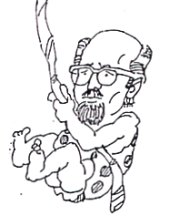 |
1992 continued to be the year of travel for me. I had dreamed of going on an African Safari for years, and I finally did. I signed up with a travel group, using AAA as my travel agent, and had my son, the pilot, obtain the necessary flight tickets. My doctor set up all the various shots I had to have. I left Pittsburgh for Frankfurt, Germany on October 6. I arrived in Germany the next day, but the connecting flight to Nairobi, Kenya had to take on extra fuel because of the long flight, and I was left behind an extra day.
But I made it to Africa in time to join my tour group at the world-famous Norfolk Hotel in Nairobi. This, the first hotel built in Nairobi, had been the starting place for many safaris and a meeting place for such notables as Teddy Roosevelt, Edward, Prince of Wales, Martin and Osa Johnson, Ernest Hemingway, Robert Rouark, Karen Blixen, Beryl Markham, Lord Delamere and John Clayton. It is still the starting location for many safaris, but today they consist of tourists in minivans. . . and there are no porters or oxen-pulled wagons. The hotel was filled with people ready to depart on safari or just returning from one. After almost sixty years of reading about Africa as Edgar Rice Burroughs had described it, I was hoping to following Tarzan's footsteps and discover the places and animals Burroughs had so vividly described. In my mind, he had built up an ideal picture of Tarzan's Africa. Although Tarzan ranged over nearly all of Africa, I knew I would be able to see only one small section in my journey; that of East Africa. I found less jungle, and more dry plains than he described.
Our tour group of thirteen people began the trip by staying at a lodge in the Amboseli Game Reserve south of Nairobi, with a view of Mt. Kilimanjaro across the near border in Tanzania. This was on the plains, replete with all the plains game animal, especially wildebeest, pacco (zebra) and gorgo (Cape buffalo). There also were many tantor at this Game Reserve.
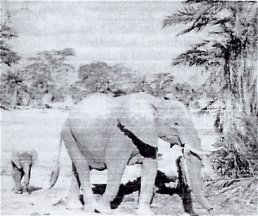
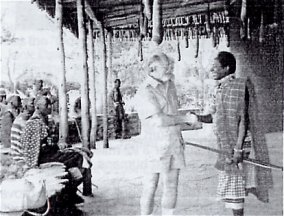
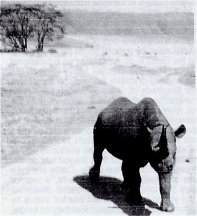
It was very dry and dusty. I wondered how so many animals could find enough food and water to stay alive. The grass was all brown stubble.But Maasai herdsmen were still driving their kalos (cows) about he plains trying to find grass for them. Manu & tongani were pests, trying to get into the dining area at the lodge to steal food, and we saw dango and ska, who clean up any carcasses left over from a kill.
From Amboseli, we crossed the border south into Tanzania, heading for the extinct volcano, Ngorongoro Crater. This 10- by 12-mile crater had sunk down inside the volcano a few million years ago and is now a paradise for wildlife. All the plains animals can be found there, plus numa, tantor, sheeta, and the now very scarce buto. We had to drive up the outside of the volcano (obviously the Mutia Escarpment) to reach our lodge on the top of the rim.
We drove down onto the crater floor and saw wildlife by the hundreds. There are dozens of types of wappi and bara in Africa, so many that I've lost count of all I saw. I was told that the ruins of an ancient city built of cut stones have been found inside the crater. There is no known history of ancient Africans building cities of cut stones in that part of Africa. I am convinced this must be Opar, but I could not get our guide to drive me to that location.
On this drive north, we made a visit to the Olduvai Gorge Museum. The Leakeys found human fossils from over 3 1/2 million years ago in the gorge where the first humans are believed to have evolved.
After we left the Serengeti plains and drove back south of Ngorongoro to Lake Manyera, we traveled through a tropical rain forest (a veritable jungle). Without having ot be asked, our guide told me that a film crew came into this jungle during the late 1950s to film a Tarzan movie. I assume this would have been one of the Gordon Scott films, "Greatest Adventure" or "Magnificent." As soon as we crossed back into Kenya we changed our mode of travel from minivan to a small 18-passenger prop plane. We flew west form Nairobi across the great Rift Valley to the northern part of the Serengeti plains, where we stayed in tents along the Mara River. These were not camping-trip tents but more like motel cabins. I saw dozens of duro in the river from the campsite. Again in this area, known as the Maasai Mara, lived all the plains animals and many numa, as well as the Maasai natives.
A visit to a Maasai village of fourteen cow-dung huts, surrounded by a thorn boma (to keep numa out and the cattle in at night), was an educational experience. They live in small family villages or shamba, in very primitive fashion, as they have done for hundreds of years. Although the Kenya government has established schools for the children, most parents to adopt a modern lifestyle. A few have gone to missionary schools and learned to speak English, but most return to their native villages where they revert to their preferred way of pastoral life.
In years past they waged war on the other tribes to obtain more cattle. Cattle are their measure of wealth. To obtain a wife, a warrior must pay the bride's father in cattle. In earlier days, the young men achieved warrior status by killing a lion, using only a spear. But they no longer wage war or kill lions, except in self defense. When they are out herding their cattle they always carry a spear to defend themselves and their cattle. We saw one Maasai warrior who had taken refuge up a tree from an attacking Cape buffalo. The Maasai are peaceful and friendly people, now selling souvenirs to tourists for money to buy grain to supplement their diet of milk and blood; they raise no crops.
I even went to a hot-air balloon safari over the plains to get a silent panoramic view of the animals from above. This ride was topped off with a champagne crew breakfast after we landed, prepared by the ground crew of the balloon.
After flying back to Nairobi from the Mara River camp, we used the minivan transportation again and drove northwest to the high mountain rain forest of the Aberdare Mountains. This drive was through the rich farmland of the Kenya highlands plateau. We passed many large plantations along the way. This would have to be the location of the Greystoke Ranch, but I must have missed it.
In the Aberdare Mountain Reserve we stayed at "The Ark," a lodge with a night-lighted water hole. A "spotter" stays up all night and sets off an alarm buzzer near the visitor's bed when animals came to the water hole. I slept on the bed fully clothed, because the buzzer went off four or five times during the night. On one memorable occasion three lions tried to bring down a Cape buffalo.
This was unusual since the buffalo are large and powerful. The spotter said the lions must have been awfully hungry because a zebra is their usual prey more often than not. All three lions were clinging to the bloody back of the buffalo, trying to get at its neck for the kill. The buffalo shook them off, but the lions would surround him and attack again. This went on for about half an hour until the buffalo ran out of range of the spotlights, followed by the lions. The spotter said the lions would eventually wear out the buffalo and make their kill by morning.
From Aberdare we drove to the Samburu area north of Mt. Kenya, which was full of wildlife I hadn't seen elsewhere on my safari: for example, the reticulated giraffe, gimla (crocodile), and the elusive cheetah (not the Hollywood chimp). An unusual sight for me was a gernuk (a type of antelope), which stands on its hind legs to browse on the leaves of higher tree branches. Supposedly, they do not need water and survive on dew.
From the Samburu on our way to the Mt. Kenya Safari Club we drove south (again) to the equator. We stopped to see a demonstration of how water swirls down a drain. . . both clockwise and counterclockwise south and north of the equator. It goes straight down at the equator itself.
One of the founders of the luxurious Mt. Kenya Safari Club was the American actor, William Holden, who helped establish a wild-animal orphanage located there. Attendants try to raise wild animals found orphaned and then release them back into the wild. The club is located 6400 feet up the slope of snow-covered Mt. Kenya, and it gets very cold at night. Log fires were burning in every bedroom all night long.
A dozen Chuka drum dancers put on a show for us. They wore large ostrich plumed headpieces and I immediately identified them as Waziri although they used a different name for their public appearances.
The next day the vans took us back to the Norfolk Hotel in Nairobi and ot the end of an unforgettable safari. I calculated that we had driven 1700 miles, plus the small-plane flight of 300 miles. 'But for me, there was more. Just as Tarzan made a trip to Egypt in the Hal Foster Sunday pages (1932-1933). I journeyed to Egypt from Nairobi. I spent a week exploring the pyramids, the sphinx and ancient temples. Alas, I found no sign of "Tutamken" or "Nikotris."
I sailed up the Nile River to the Aswan Dam, then flew up to the end of Lake Nasser to tour the Temples of Ramses II, and his queen Nefertari. These temples, carved out of the mountain to escape the flooding, had to be cut apart and moved up the mountain when the High Dam was built.
My travels next took me to Rome, where I met Franco Grillo, who was publishing the old daily and Sunday Tarzan strips in Italian comic books. Franco speaks no English, and I speak no Italian, but we managed to get our ideas across to one another. For two evening meals we had an interpreter with us who regularly translates our letters. This was a great help. Franco took me on a walking tour of the Roman ruins in the city, and I felt as though I were reliving Tarzan and the Lost Empire. When we walked through the old Roman forum and emerged on the Palatine I had thoughts of Britannicus and the death of Caligula there, almost 2000 years ago.
From Rome, over the snow covered Alps to Frankfurt, Germany and then to beautiful Pittsburgh! A fantastic five-week journey!
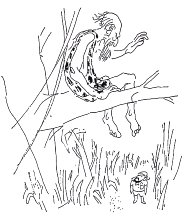
". . . And if you see Edgar Rice Burroughs
tell him for me he's an ungrateful,
cheap, plagiarizing, thieving. . . ."
BACK TO
Bob Hyde's
ODYSSEY OF A TARZAN FANatic
Navigation Chart and Introduction

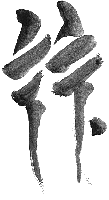
BILL HILLMAN
Visit our thousands of other sites at:
BILL AND SUE-ON HILLMAN ECLECTIC STUDIO
ERB Text, ERB Images and Tarzan® are ©Edgar Rice Burroughs, Inc.- All Rights Reserved.
All Original Work ©1996-2004/2010 by Bill Hillman and/or Contributing Authors/Owners
No part of this web site may be reproduced without permission from the respective owners.